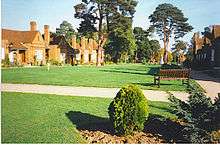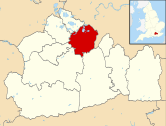Whiteley Village


Whiteley Village, in Hersham, Surrey, England, is a retirement village, much designed architecturally by Arts and Crafts movement-influenced architect Reginald Blomfield. It is owned by the Whiteley Homes charitable trust and is on land which was once part of Walton Firs and Walton Heath, before the parish of Hersham was created in the 19th century.
History
Whiteley Village formed as the result of a bequest of £1,000,000 realised in 1907 upon the death of William Whiteley (equivalent to £95,404,290 in 2015). The village is owned and administered by the Whiteley Homes Trust, a charity registered in the UK,[1] and provides almshouses for older people of limited financial means. The village also contains an extra-care facility (51 self-contained flats with domiciliary care) and a 100-bed nursing and residential care home.[2] The land on which the community sits is at on the gravel-rich lower slopes of the much higher bank of the River Mole, Surrey, 10–15 metres above the level of the tributary.[3] Its surrounding buffer land has remained the most wooded part of its two historic parishes, and until the 19th century was wholly part of Walton Firs and Walton Heath in Walton on Thames.[4] Hersham is one of the most recently created chapelries and villages in Surrey, created in 1851 from the southern part of Walton-on Thames. It is, roughly, the part of the original parish south of the South Western Main Line. Its first Church of England place of worship, a chapel of ease was built of yellow brick in Anglo-Norman style in 1839.[5]
Architecture
In addition to the care and housing provided, a major feature of Whiteley Village is that it consists of more than one hundred listed buildings, which together form an important collection of Arts and Crafts movement as it applies to a style of architecture.[2] Much of the design work here was by architect Reginald Blomfield.[6] This movement was particularly a main style in and around the neighbouring area to the west which is partly in the parish of Weybridge, Saint George's Hill where W.G. Tarrant was a major designer-builder and saw its early evolution in many Surrey examples of Lutyens's work. It remains a style occasionally used where building costs allow it to be implemented without forsaking its original decorative and traditional core principles.[7]
Amenities
Whiteley Village contains two churches, a museum, a shop and post office, launderette, charity shop, library, therapy pool, licensed clubhouse, café, putting green, bowls green, golf club and 21 clubs/societies, Village Hall and as such is an example of a model village, which evolved in England in a short period of time and has protected-status wooded and golf course buffer zone land around it.
Location
 |
Weybridge | Burwood Park | Hersham |  |
| St George's Hill | |
Across river and fields of Fairmile, Cobham Claremont Landscape Garden | ||
| ||||
| | ||||
| Silvermere | Painshill Park | Cobham |
References
- ↑ Charity Commission. The Whiteley Homes Trust, registered charity no. 1103056.
- 1 2 Whiteley Village
- ↑ Grid square map Ordnance survey website
- ↑ H.E. Malden (editor) (1911). "The hundred of Elmbridge: Introduction and map". A History of the County of Surrey: Volume 3. Institute of Historical Research. Retrieved 1 January 2014.
- ↑ H.E. Malden (editor) (1911). "Parishes: Walton on Thames". A History of the County of Surrey: Volume 3. Institute of Historical Research. Retrieved 1 January 2014.
- ↑ Examples of one of the largest Grade II buildings - Historic England. "Details from listed building database (1365902)". National Heritage List for England.
- ↑ Cumming, Elizabeth; Kaplan, Wendy (1991). Arts & Crafts Movement. London: Thames & Hudson. ISBN 0-500-20248-6.
External links
- Whiteley Village
- Whiteley Village on Facebook
- Whiteley Village channel on YouTube
- Sports Courses in Whiteley Village Organised by Reeds RFC
- Whiteley Village Cricket Club
See also
![]() Media related to Whiteley Village at Wikimedia Commons
Media related to Whiteley Village at Wikimedia Commons
![]() Surrey portal
Surrey portal
Coordinates: 51°21′01″N 0°25′39″W / 51.35037°N 0.42747°W
